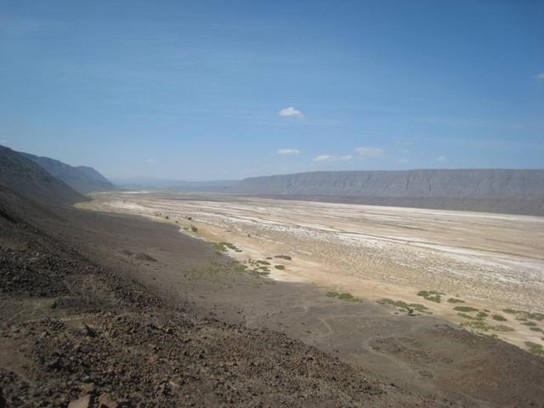
Dobi graben bound by normal faults cutting through the Afar Stratoid Series. The pale brown/white deposits are evaporites. Photograph by Lorraine Field, University of Bristol.
Geology of the East-Central Afar Rift
The East Central Afar region is bounded by the Tendaho–Gobaad Discontinuity (TGD) (a zone of unclear origin across which the orientation of the faults change) in the west and southwest, the Ali-Sabieh Block in the southeast and the southern end of the Danakil Block in the east. Quaternary (~last two million years) extension has lead to the formation of faults with a variety of orientations across the whole area. In many places these have formed narrow, overlapping, northwest-southeast trending basins. The area is dominated by the Plio-Pleistocene Afar Stratoid Series with only minimal Quaternary volcanic activity and has an average crustal thickness of about 25km.
The East Central Afar region consists of two major rift systems: in the east is the northwest propagating Ghoubbet–Asal–Manda Inakir rift system which links to the Gulf of Aden through the Gulf of Tajura and in the west is the southeast-propagating Manda Hararo–Gobaad rift which links with the rift systems in Northern Afar. The Ghoubbet–Asal–Manda Inakir rift began to open about 1Ma and propagation has been episodic with alternating phases of magmatism and faulting.
The area between the two rift systems is known as the East-Central block and has undergone clockwise rotation and northeast-southwest directed extension due to the different spreading rates of the rift systems. It is characterized by a series of major fault bounded basins such as the northwest-southeast trending Dobi graben (photo 3 + link). It was the site of a swarm of shallow earthquakes in 1989.
The TGD in the south forms a boundary across which there is a sudden change from rapid northeast-southwest directed extension in the Northern and East Central Afar regions to slow WNW-ESE directed extension in Southern Afar and the Main Ethiopian Rift.
For references used, please see technical version.
